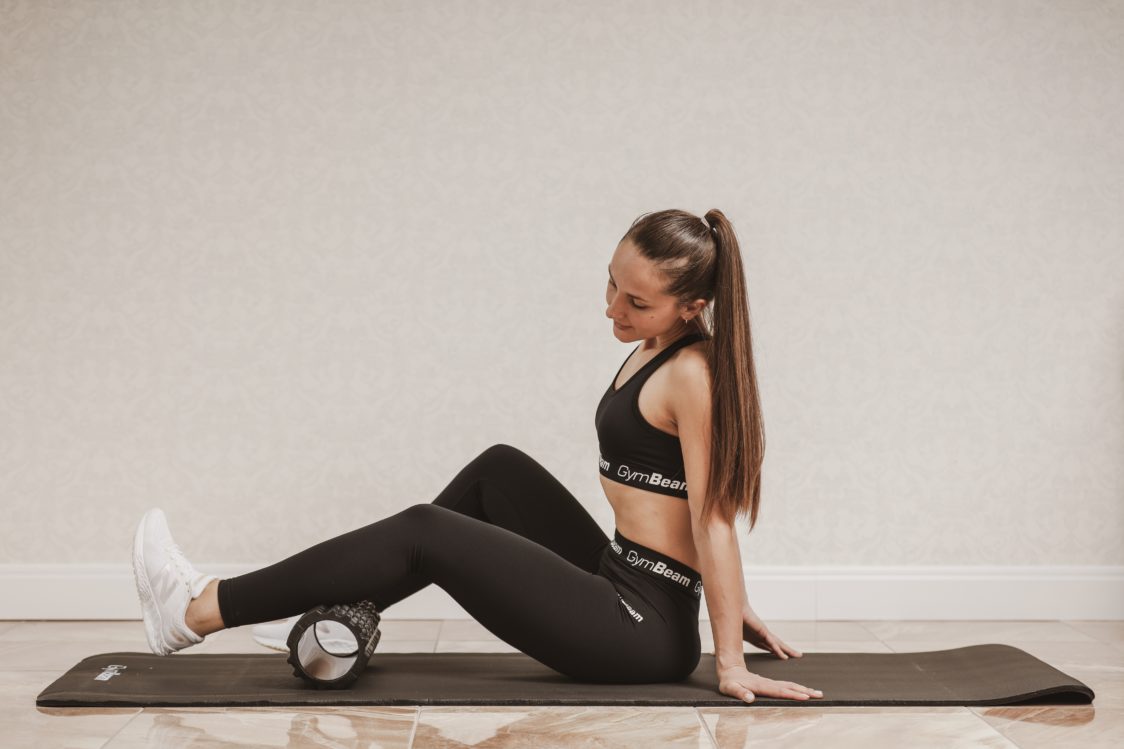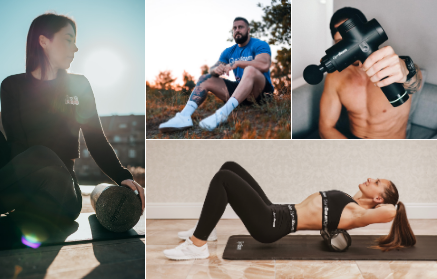Table of Contents
If you want to successfully achieve your fitness goals, you should stick to the three key points. The first is exercise, the second is diet tailored to your needs and the third is regeneration which is one of the most underestimated of those three activities. Many of us don’t realize that muscles don’t grow during the exercise, but the real magic happens after it.
Every physical exercise must be therefore compensated by appropriate rest time. Otherwise, your efforts in the gym may be accompanied by considerable problems. These can ultimately also affect your overall health. And so today we will talk about how to properly regenerate and what can be done to improve this often neglected activity.
Importance of regeneration
Regeneration is a natural process that involves the activity of the body, leading to the complete recovery of mental and physical strength, damaged by previous exercise. It should be understood as a regular part of training, since the muscles are damaged during repetitive and intensive exercise. This physical exercise causes small damage in the muscle fibres. [21]
If the body does not have enough time to recover, the risk of injury to the soft tissues and the entire musculoskeletal system increases. The body can be overloaded with unreasonably high training load. As a result, you may feel a lack of energy, fatigue, increased muscle soreness and an aversion to exercise. Other symptoms may be indigestion or general exhaustion of the body. [1] [5] [21]

Here are two basic types of regeneration that can help:
- Passive: is the most common and takes place automatically during the next hours after exercise, when the body immediately replenishes the energy reserves from adequately planned nutrition, and processes such as the synthesis of muscle proteins happens here. You can support it with a suitable post-workout supplementation. [2-3] [21]
- Active: is a planned activity involving the use of all methods and means to accelerate the process of passive regeneration [2-3] [21]
It is important to find time for regeneration because during this period the body recovers from the load caused by training. Part of this process is quality sleep which should not be underestimated. Lack of it can cause considerable problems which you can learn more about in our article What happens to your body when you don’t get enough sleep?
If you do not give your body enough rest, you are at risk of overtraining which can jeopardize your goal achievement. We will talk more about them below.
Risks associated with the lack of regeneration
Inefficient regeneration can lead to physical performance decrease and to overtraining syndrome. Its most common symptoms are [7-9]:
- pain and muscle tension
- fatigue and annoyance
- decrease in performance
- weight loss
- thirst and loss or increase in appetite
- interrupted sleep
- increased resting heart rate
- metabolic disorder
- exercise reluctance
- negative impact on sex life
- night sweats
- indigestion
Furthermore, a study in the journal Sports Health found that insufficient regeneration can contribute to impaired function of the immune system, neurological changes, hormonal disorders or depression. [5]
Regeneration support in the form of massage
If you want to help your body to recover, you can choose one of two ways. The first is active rest in the form of light physical activity (cycling or running) and the second is passive rest which you will support, for example, with hydrotherapy or massage. Massages are among the best techniques for regeneration, muscle relief and post-workout fatigue. They are also supported by several studies which have shown that [10-13] [21]:
- a 20-30 minute massage performed either immediately or 2 hours after training can effectively reduce the symptoms of delayed onset muscle pain (DOMS) to 24 hours after exercise
- the combination of stretching with massage can help reduce fatigue
- a study observing leg recovery after training found that participants who underwent massage had their legs recovered faster than those who did not undergo massage at all
There are many useful massage tools which can come in handy. They will speed up the time your body needs to rest, and you will allow you to exercise again soon. The tools mentioned below will help you to do effective massages at home as well. [4]
You might be interested in these products:
3 effective massage tools
High-quality massage tools can help you with an effective massage. There are other benefits they offer, including [14]:
- blood circulation improvement
- wider range of motion and better flexibility
- reduction of muscle pains
- relaxation support
- complex support of body regeneration
Below we offer an overview of effective massage tools that will help you during your home massage.

1. Massage rollers
Massage rollers are tools made of foam. They help increase range of motion and relieve muscle tension or pain. They can serve as injury prevention or as a relaxation tool. Furthermore, they offer various types of surfaces in order to achieve an even more effective massage. There are several studies that confirm the benefits of their use, and the conclusions are as follows [16-18]:
- men who were using massage rollers 20 minutes after training reduced the symptoms of delayed onset of muscle pain to 24 up to 48 hours after exercise
- the combination of massage with a foam roller and static stretching was most effective for increasing the range of motion
- participants with fibromyalgia (muscle disease) who had been using a foam roller for 20 weeks stated that they felt better, had less pain, and were less tired or stiff

2. Massage balls
Massage balls, like foam rollers, are also popular for muscle tension relief. They help relieve muscles not only after training, but also after long hours spent sitting in the office. Their advantage compared to the massage rollers is that they can more easily get to hard-to-reach areas, such as the upper and lower spine or feet, thanks to their shape and size. In addition, they are affordable and fit in a suitcase, purse or backpack. [20]

3. Massage guns
Massage guns are a functional alternative to foam rollers which are used to relieve stiff muscles. They offer an effective system that may be appreciated by a lot of different sportsmen. They help relieve muscle tension, reduce pain and improve blood flow. At the same time, massage guns can serve as a good prevention against DOMS. The advantages of the massage gun include:
- several intensity levels with high speed
- wireless use and long battery life
- low weight and ergonomic shape
- several different massage heads
Moreover, massage guns will also serve well in the case of self-massage to relieve fascia. The higher-quality ones are also equipped with an LCD display. You can use them before training to warm up your muscles or after it to relieve tension. Their benefits have also been studied in various studies that have found that [19] [22 – 24]:
- vibration massage is as effective as classic massage in the case of DOMS prevention
- vibration massage can have a positive effect on muscle performance
- vibration therapy helps to increase blood flow
- vibration therapy can help improve strength and mobility in people who suffer from peripheral artery disease
Summary
Regeneration is one of the most underrated parts in the world of fitness. However, it is just as important as the training or diet itself. Therefore, we should give our body an appropriate rest as a compensation for the prior physical exercise. Regeneration does not necessarily have to be passive, but it can also be active. It can help you exercise more often, more intensively and more effectively which is a great benefit.
One of the most effective active forms of regeneration is massage. You can also do it at home using massage tools. They will help you relieve muscle tension, improve blood circulation, increase range of motion, relax, but also prevent the delayed onset of muscle pain, known as DOMS. Currently, the most modern home self-massage tools are massage guns. They have many functional advantages which are confirmed by several researches.
And what about you and regeneration? Do you think it is important, or you should pay more attention to it? If you liked the article, don’t forget to share it, so that this inspiring information reaches your friends as well.
[1] Regeneration – https://www.nigms.nih.gov/education/fact-sheets/Pages/regeneration.aspx
[2] Regenerační a sportovní masáž – https://is.muni.cz/elportal/estud/fsps/ps09/masaz/web/pages/regenerace.html
[3] Elizabeth Quinn - Importance of Rest and Recovery After Your Exercise – https://www.verywellfit.com/the-benefits-of-rest-and-recovery-after-exercise-3120575
[4] Jonathan Ross - Passive Vs. Active Recovery: Which is More Effective? – https://www.acefitness.org/education-and-resources/professional/expert-articles/5456/passive-vs-active-recovery-which-is-more-effective/
[5] Jeffrey B. Kreher, Jennifer B. Schwartz - Overtraining Syndrome – https://www.ncbi.nlm.nih.gov/pmc/articles/PMC3435910/
[6] Caroline Roberts - Overtraining Syndrome – https://www.cnet.com/health/fitness/why-workout-recovery-is-so-important/
[7] Emily Cronkleton - 13 Signs of Overtraining and What to Do About It – https://www.healthline.com/health/signs-of-overtraining#signs-and-symptoms
[8] What Happens When You Don’t Recover Properly? – https://www.triathlete.com/training/recovery/happens-dont-recover-properly/
[9] Justin Robertson - Overtraining | 9 Signs of Overtraining to Look Out For – https://www.acefitness.org/education-and-resources/lifestyle/blog/6466/overtraining-9-signs-of-overtraining-to-look-out-for/
[10] Rui Torres, Fernando Ribeiro, José Alberto Duarte, Jan M H Cabri - Evidence of the physiotherapeutic interventions used currently after exercise-induced muscle damage: systematic review and meta-analysis – https://pubmed.ncbi.nlm.nih.gov/22498151/
[11] Jianmin Guo, Linjin Li, Yuxiang Gong, Rong Zhu, Jiake Xu, Jun Zou, Xi Chen - Massage Alleviates Delayed Onset Muscle Soreness after Strenuous Exercise: A Systematic Review and Meta-Analysis – https://pubmed.ncbi.nlm.nih.gov/29021762/
[12] Anne Delextrat, Audrey Hippocrate, Sheila Leddington-Wright, Neil D Clarke - Including stretches to a massage routine improves recovery from official matches in basketball players – https://pubmed.ncbi.nlm.nih.gov/24561594/
[13] Justin D Crane, Daniel I Ogborn, Colleen Cupido, Simon Melov, Alan Hubbard, Jacqueline M Bourgeois, Mark A Tarnopolsky - Massage therapy attenuates inflammatory signaling after exercise-induced muscle damage – https://pubmed.ncbi.nlm.nih.gov/22301554/
[14] Shelby Whitmore - How massage therapy benefits workout recovery – https://ridgeathletic.com/how-massage-therapy-benefits-workout-recovery/
[15] Thomas M. FACSM, Huard, Johnny, Patel, Kunj, Crawford, Scott K. - Massage Increases Muscle Fiber Regeneration And Angiogenesis And Decreases Fibrosis Following Eccentric Exercise Injury – https://journals.lww.com/acsm-msse/fulltext/2015/05001/Massage_Increases_Muscle_Fiber_Regeneration_And.1555.aspx
[16] Gregory E. P. Pearcey, David J. Bradbury-Squires, Jon-Erik Kawamoto, Eric J. Drinkwater, David G. Behm, Duane C. Button - Foam Rolling for Delayed-Onset Muscle Soreness and Recovery of Dynamic Performance Measures – https://www.ncbi.nlm.nih.gov/pmc/articles/PMC4299735/
[17] Jakob Škarabot, Chris Beardsley, Igor Štirn - Comparing the effects of self-myofascial release with static stretching on ankle range-of-motion in adolescent athletes – https://pubmed.ncbi.nlm.nih.gov/25883869/
[18] Diego Ceca, Laura Elvira, José F Guzmán, Ana Pablos - Benefits of a self-myofascial release program on health-related quality of life in people with fibromyalgia: a randomized controlled trial – https://pubmed.ncbi.nlm.nih.gov/28139112/
[19] Zubia Veqar, Shagufta Imtiyaz - Vibration Therapy in Management of Delayed Onset Muscle Soreness (DOMS) – https://pubmed.ncbi.nlm.nih.gov/25121012/
[20] How to use a massage ball – https://thephysiocompany.co.uk/how-to-use-a-massage-ball/
[21] Bernaciková, M., Masarykova univerzita, & Fakulta sportovních studií. – Regenerace a výživa ve sportu (1. vyd.)
[22] Shagufta Imtiyaz, Zubia Veqar, M.Y. Shareef - To Compare the Effect of Vibration Therapy and Massage in Prevention of Delayed Onset Muscle Soreness (DOMS) – https://www.ncbi.nlm.nih.gov/pmc/articles/PMC3939523/
[23] A J Herrero,, H Menéndez, L Gil, J Martín, T Martín, D García-López, A Gil-Agudo, P J Marí - Effects of whole-body vibration on blood flow and neuromuscular activity in spinal cord injury chttps://pubmed.ncbi.nlm.nih.gov/21042329/]
[24] Darryl J.Cochrane, Fiona Cochrane, Justin A.Roake - An exploratory study of vibration therapy on muscle function in patients with peripheral artery disease – https://www.sciencedirect.com/science/article/abs/pii/S0741521419319354


Add a comment